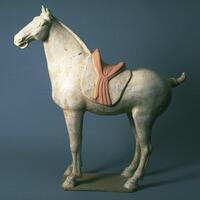10 UMMA Objects
10 UMMA Objects

Chinese (Chinese (culture or style))
Mirror, "Marriage type" (with lobed rim and paired design motifs)
600 – 799
Museum purchase for the James Marshall Plumer Memorial Collection
1961/2.62
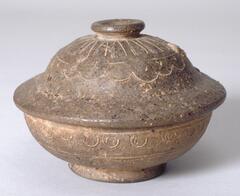
Korean (Korean (culture or style))
Cinerary urn with triangular circle-and-dot design
7th century
Gift of Mrs. Caroline I. Plumer for the James Marshall Plumer Collection
1973/2.36A&B
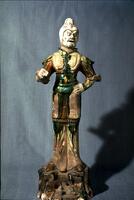
Chinese (Chinese (culture or style))
Warrior
667 – 732
Transfer from the College of Architecture and Design
1972/2.68
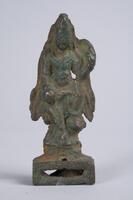
Chinese (Chinese (culture or style))
Bodhisattva, seated in lalitasana: part of a miniature shrine
600 – 799
Gift of Marybelle B. Hanna
2001/1.363
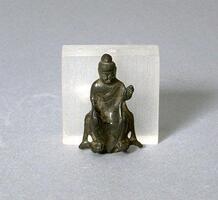
Chinese (Chinese (culture or style))
Buddha, seated in the pralambapadasana pose (with legs pendant), in abhaya mudra
600 – 799
Museum purchase for the James Marshall Plumer Memorial Collection
1964/2.92

Korean (Korean (culture or style))
Cinerary urn with concentric circles design
600 – 799
Gift of Mrs. Caroline I. Plumer for the James Marshall Plumer Collection
1973/2.34A&B
![Stoneware bottle with a squat body, cylindrical neck, flared rim and natural ash glaze. A band stretches along the base of the neck demarcated by two outside lines, and a stamped row of stylized flowers centered in between them. Below the band the body of the bottle dramatically begins to curve outward. Along the body are a series of vertical comb-punched radiating lines.<br />
<br />
This is a dark gray, high-fired stoneware bottle decorated with a stamped design. The shape of the body is spheroidal, while its mouth is wide. A set of raised bands surrounds the center of the neck, while the area below is decorated with a row of stamped semicircular motifs. The upper part of the body is surrounded by rows of vertical dotted lines which have subsequently been erased from parts of the lower body by paring during rotation. The foot is low and slightly splayed.
<p>[Korean Collection, University of Michigan Museum of Art (2017) p. 82]</p>
Stoneware bottle with a squat body, cylindrical neck, flared rim and natural ash glaze. A band stretches along the base of the neck demarcated by two outside lines, and a stamped row of stylized flowers centered in between them. Below the band the body of the bottle dramatically begins to curve outward. Along the body are a series of vertical comb-punched radiating lines.<br />
<br />
This is a dark gray, high-fired stoneware bottle decorated with a stamped design. The shape of the body is spheroidal, while its mouth is wide. A set of raised bands surrounds the center of the neck, while the area below is decorated with a row of stamped semicircular motifs. The upper part of the body is surrounded by rows of vertical dotted lines which have subsequently been erased from parts of the lower body by paring during rotation. The foot is low and slightly splayed.
<p>[Korean Collection, University of Michigan Museum of Art (2017) p. 82]</p>](/media/W1siZiIsIjIwMjIvMDkvMjQvMzg5Zmw5ZG9nc19kZWZhdWx0LmpwZyJdLFsicCIsInRodW1iIiwiMjQweDIwMCJdXQ?sha=9b777eff01ef9ade)
Korean (Korean (culture or style))
Bottle with Stamped Flower and Bead Designs
600 – 799
Gift of Bruce and Inta Hasenkamp and Museum purchase made possible by Elder and Mrs. Sang-Yong Nam
2004/1.194

Korean (Korean (culture or style))
Cinerary urn with circle-and-dot design
7th century
Gift of Mrs. Caroline I. Plumer for the James Marshall Plumer Collection
1973/2.35A&B
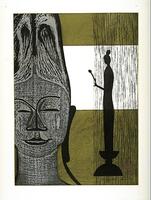
Saitō Kiyoshi (Japanese (culture or style))
Buddha (B); image of a famous 7th-century sculpture at Hôryûji, Nara
1959
Gift of Dr. Lawrence Preuss
1987/1.240
Loading…
